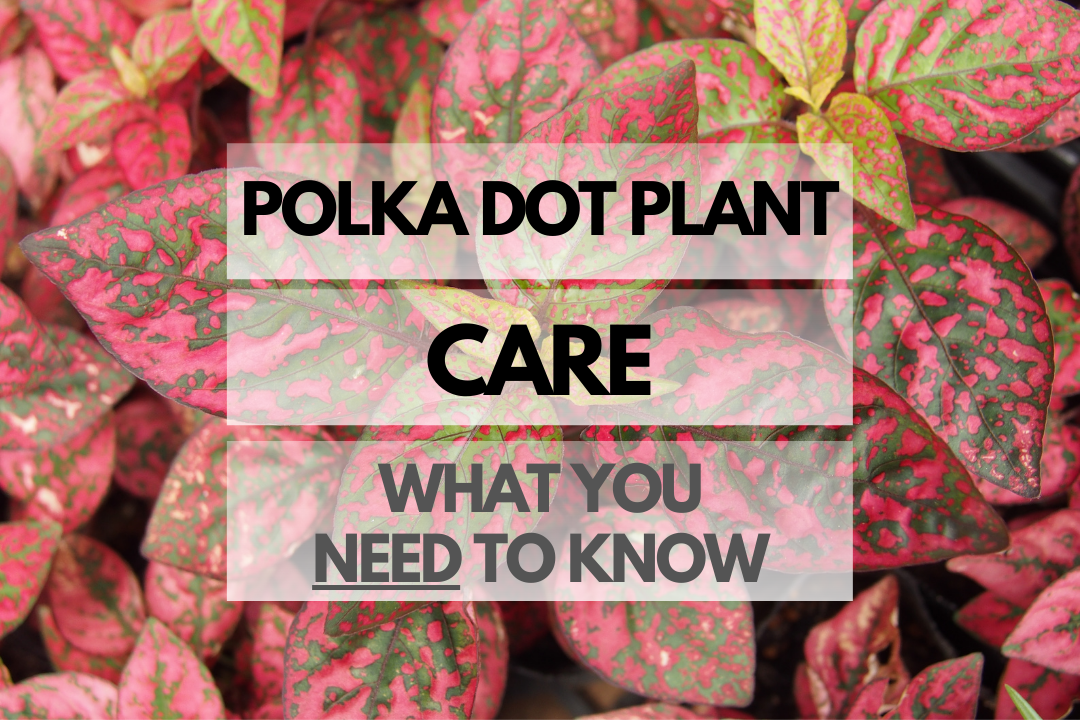Polka Dot plants, also known as Hypoestes phyllostachya, are vibrant, eye-catching houseplants known for their spotted foliage. With their unique appearance and easy-to-grow nature, they make an excellent addition to any indoor garden. In this care guide, we’ll dive into everything you need to know to keep your Polka Dot plant healthy and thriving.
Polka Dot Plant Care Guide
Quick Reference Table: Caring for Polka Dot Plant
| Aspect | Requirement |
|---|---|
| Sunlight | Bright, indirect light |
| Soil | Well-draining, peat-based potting mix |
| Watering | Keep soil consistently moist but not soggy |
| Pruning | Regularly pinch back or trim to maintain bushy growth |
| Temperature | 60-80°F (16-27°C) |
Polka Dot Plant Sunlight: Do They Need It and How Much?
Polka Dot plants thrive in bright, indirect light, which helps maintain their vibrant foliage colors. These plants can tolerate lower light conditions, but their leaf colors may become less intense. Direct sunlight should be avoided, as it can scorch the leaves and cause them to lose their vibrant coloration.
Polka Dot Plant Soil Tips
A well-draining, peat-based potting mix is ideal for Polka Dot plants. The soil should retain moisture without becoming soggy, preventing root rot. You can create your own mix by combining equal parts peat moss, perlite, and potting soil, or purchase a pre-made mix designed for African violets or other moisture-loving plants.
Polka Dot Plant Watering and Frequency
Polka Dot plants prefer consistently moist soil, but it is important not to overwater and cause root rot. Water your plant when the top inch of soil feels slightly dry, making sure to thoroughly wet the soil without causing it to become soggy. During hotter months, you may need to water more frequently, while during cooler months or periods of lower light, you can reduce the watering frequency.
Pruning Polka Dot Plant Properly
To maintain a bushy growth habit and prevent legginess, regularly pinch back or trim your Polka Dot plant. This will encourage branching and keep the plant compact. Pruning can be done at any time, but it is best to do it during the active growing season in spring and summer.
Optimal Polka Dot Plant Temperature: Can They Tolerate the Cold?
Polka Dot plants are tropical in nature and prefer temperatures between 60-80°F (16-27°C). They can be sensitive to cold drafts and should be kept away from windows and doors during the winter months. If temperatures drop below 50°F (10°C), the plant may experience leaf loss or other signs of stress.
Common Polka Dot Plant Problems
Leaf Loss
Leaf loss in Polka Dot plants can be caused by a variety of factors, including low humidity, cold drafts, or underwatering. To prevent leaf loss, maintain consistent moisture levels in the soil, keep the plant in a warm environment, and increase humidity by misting, using a humidifier, or placing the plant on a tray of pebbles with water.
Fading Leaf Color
If the vibrant colors of your Polka Dot plant’s leaves start to fade, it may be due to insufficient light. Move your plant to a brighter location with indirect sunlight to help restore its vivid coloration.
Leggy Growth
Leggy or spindly growth in Polka Dot plants is often a result of inadequate light or insufficient pruning. To promote bushy growth, ensure your plant receives enough bright, indirect light and regularly pinch back or trim the stems to encourage branching.
Polka Dot Plant Outdoors vs Indoors
Polka Dot plants can be grown both indoors and outdoors, but they are primarily grown as houseplants due to theirtropical nature and sensitivity to cold temperatures. Here are some pros and cons of growing Polka Dot plants in each environment:
| Location | Pros | Cons |
|---|---|---|
| Indoors |
|
|
| Outdoors |
|
|
Best Pots for Polka Dot Plant
When choosing a pot for your Polka Dot plant, select one with drainage holes to prevent waterlogged soil and root rot. A well-draining potting mix is crucial, so using a pot made of a breathable material, such as terracotta, can be beneficial. However, any type of pot will work as long as it provides proper drainage. A decorative outer pot or saucer can be used to catch excess water and enhance the plant’s appearance.
Polka Dot Plant Facts
Polka Dot Plant Benefits
- Aesthetic appeal: With their bright, spotted foliage, Polka Dot plants add a pop of color and visual interest to any indoor space.
- Easy to grow: As long as their basic care requirements are met, Polka Dot plants are relatively low-maintenance and can thrive in a variety of indoor environments.
- Air purification: Like many houseplants, Polka Dot plants can help improve indoor air quality by removing pollutants and releasing oxygen.
Growth Rates: How Fast Do They Grow?
Polka Dot plants are relatively fast growers, especially during their active growing season in spring and summer. With proper care, they can reach maturity within a few months. Regular pruning can help maintain a compact and bushy growth habit, which is desirable for this plant.
Polka Dot Plant Lifespan
Polka Dot plants are typically grown as annuals, but they can live for several years if properly cared for. They may lose some of their vibrancy and become leggy with age, but regular pruning can help maintain their appearance and extend their lifespan.
Are Polka Dot Plants Safe?
Polka Dot plants are considered non-toxic to humans and pets, making them a safe option for households with children, cats, and dogs. However, it is always best to keep plants out of reach of curious pets and young children to prevent any potential issues.
Polka Dot Plant Flowers
Polka Dot plants occasionally produce small, insignificant purple or lavender flowers. While the flowers are not their main attraction, they can add an extra layer of interest to the plant. Some growers may choose to remove the flowers to focus the plant’s energy on maintaining its vibrant foliage.
Polka Dot Plant Types and Varieties
Hypoestes phyllostachya ‘Confetti’
The ‘Confetti’ variety of Polka Dot plant features green leaves covered in a mix of pink, purple, and white spots. This variety is known for its compact growth habit, making it ideal for small spaces and container gardens.
Hypoestes phyllostachya ‘Splash’
‘Splash’ is another popular variety of Polka Dot plant, characterized by its large, vibrant spots in shades of pink, red, and white. The high contrast between the green foliage and bright spots creates a striking appearance.
Hypoestes phyllostachya ‘Carmina’
The ‘Carmina’ variety boasts bright pink spots against dark green leaves, creating a bold and eye-catching display. This variety is known for its vigorous growth and bushy habit.
Polka Dot Plant Pros and Cons
| Pros | Cons |
|---|---|
|
|
Polka Dot Plant Cost
The cost of a Polka Dot plant can vary depending on the size and variety, but they are generally affordable. Small starter plants can be found for as little as $4 to $6, while larger, more established plants may cost $10 to $20.
Where to Buy Polka Dot Plants
Polka Dot plants are widely available at garden centers, nurseries, and online retailers. Some popular online sources include Etsy, Amazon, and specialty plant shops such as The Sill or Bloomscape. Local nurseries may also carry a variety of Polka Dot plants, especially during the spring and summer months.
Is Polka Dot Plant Propagation in Water Possible?
Yes, Polka Dot Plant propagation in water is possible. To propagate, simply take a stem cutting with at least one leaf node and place it in a container with water, making sure the node is submerged. Change the water every few days to keep it clean, and within a few weeks, the cuttingshould develop roots. Once the roots are well-established, the cutting can be transferred to soil.
Additional Resources
- Missouri Botanical Garden: Hypoestes phyllostachya
- Facebook Group: Houseplant Hobbyist
- Reddit Community: r/houseplants
- Book: “The Complete Houseplant Survival Manual” by Barbara Pleasant
FAQ for Polka Dot Plant Care
Are Polka Dot plants toxic to cats?
No, Polka Dot plants are considered non-toxic to cats. However, it is still best to keep them out of reach to prevent any potential issues.
Are Polka Dot plants toxic to dogs?
No, Polka Dot plants are considered non-toxic to dogs. As with cats, it is recommended to keep the plants out of reach to avoid any potential problems.
Are Polka Dot plants toxic to kids?
No, Polka Dot plants are considered non-toxic to humans. While they are safe for children, it’s always a good idea to teach kids not to touch or eat plants without supervision.
How tall do Polka Dot plants get?
Polka Dot plants can grow up to 12 to 24 inches tall, depending on the variety and growing conditions. Regular pruning can help maintain a compact and bushy growth habit.
Can Polka Dot plants live outside?
Polka Dot plants can be grown outside in USDA hardiness zones 10 and 11, where temperatures do not fall below freezing. In colder climates, they can be grown as annuals in outdoor containers or brought indoors during the winter months.
Are Polka Dot plants poisonous?
No, Polka Dot plants are not poisonous and are considered safe for humans and pets. However, it is always best to keep them out of reach to prevent any issues.
Can Polka Dot plants grow in low light?
While Polka Dot plants can tolerate low light conditions, their vibrant foliage may become less pronounced and the plant may become leggy. For best results, place them in a location with bright, indirect light.
In conclusion, Polka Dot plants are an eye-catching and easy-to-grow addition to any indoor space. With their vibrant foliage and non-toxic nature, they are a popular choice for households with children and pets. Whether you’re a seasoned plant enthusiast or just starting your houseplant collection, the Polka Dot plant is sure to impress.

